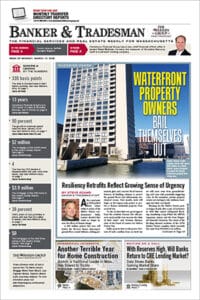A new analysis by the Pioneer Institute says that many Massachusetts towns are blunting the effect of a state law aimed at producing more housing near transit.
The free market-oriented Boston think tank analyzed zoning districts approved by dozens of towns and cities to comply with the MBTA Communities state law, passed in 2021.
While the group’s new report doesn’t put a number on how many housing units are likely to be built as a result of the law over 10 years – work by Boston Indicators and the Brookings Institution put the figure between 20,000 and 40,000 homes – it says many communities are drawing MBTA Communities zoning districts to intentionally limit how much housing can realistically be developed.
The report cites the wealthy Cambridge suburb of Arlington, whose MBTA Communities district must be able to hold 3,216 homes under state guidelines, but includes 1,981 existing homes – a number of which are on parcels nearly as dense as the zoning district’s 15-homes-per-acre cap. Taken together, the report cites Arlington town staff saying that officials expect at most 200 new homes will be built over the next 10 years, and notes that in the first nine months after it passed its MBTA Communities zoning, only one development project totaling two net units had been proposed.
“Similar complications exist in communities that have overlaid multi-family zoning in places with commercial uses, as previously developed land may have unique challenges that make redevelopment difficult, like building around existing utilities and honoring leases of existing tenants,” the report says.
The upshot: Not enough homes will be built fast enough under the MBTA Communities law to have a meaningful impact and “cause home prices to grow slower than inflation or incomes” in Greater Boston, the Pioneer report concludes.
Released the same day that the state Supreme Judicial Court heard arguments from the state attorney general’s office and lawyers representing the town of Milton whether the former could sue the latter to enforce compliance with the MBTA Communities law, the Pioneer report casts doubt on whether Boston suburbs will comply with the law without more serious threats of enforcement.
The report authors cite the limited number of homes voluntary zoning reforms like Chapter 40R have produced – only around 7,253 new homes in the 20 years it’s existed compared to the roughly 200,000 that the Healey administration says Massachusetts needs – and the ways in which most towns have complied with the letter of the MBTA Communities law, but not its spirit.
The report outlines several strategies that it says state leaders and housing advocates should adopt as they look for a way forward.
First, policymakers should prioritize incremental reforms that scales up smaller steps towns have already taken to add housing, in order to avoid alienating local officials and residents.
Second, they should target density efforts to areas that already have good sewer and water infrastructure, high-quality transit and development-ready sites. Included in this, the report argues policymakers should ramp up punishments for towns that have high-quality transit access but don’t comply with the law.
“While harsher, adjusting Chapter 70 school aid or Chapter 90 capital improvements funding based on housing and zoning policy may also be effective. After all, communities that don’t create enough housing might need less money for school or road improvements. But that would still give cities and towns ultimate control over how much housing they allow to be built,” the report says.
Third, the report says state leaders should stop trying to change local zoning and instead should circumvent it, following the model of the Chapter 40B “anti-snob” affordable housing law or Cambridge’s Affordable Housing Overlay that gives significant density bonuses to fully-affordable housing developments.







